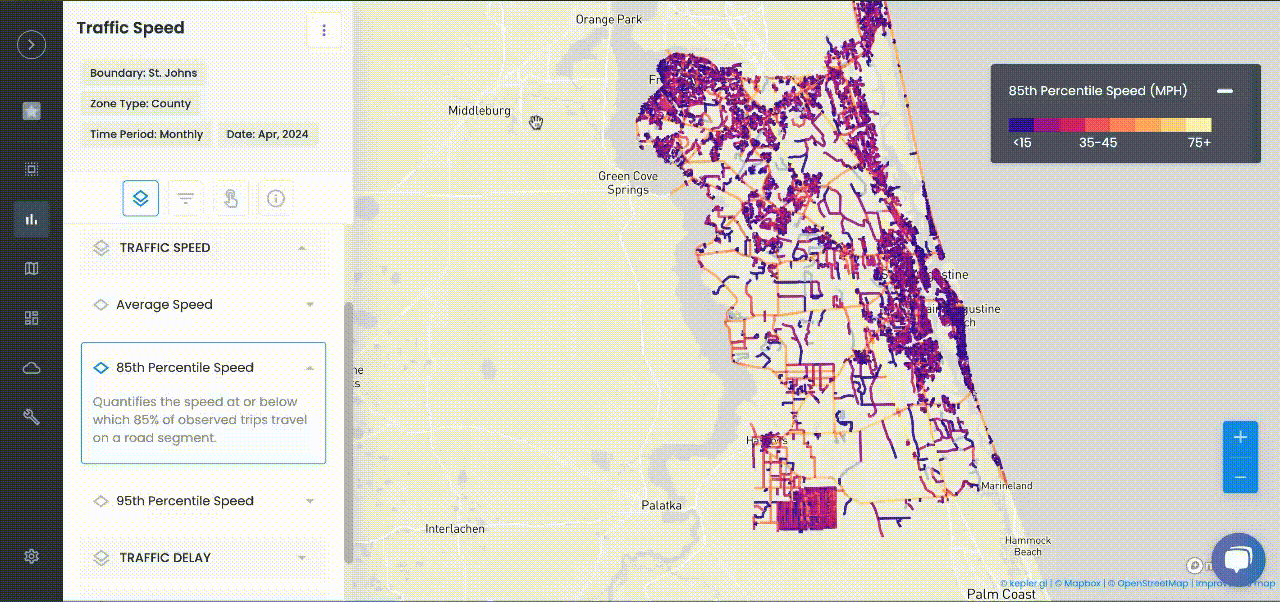
Transportation Planning
Mobility Equity in U.S. Cities: Using Data to Improve Accessible Transit for All
By using Geospatial AI and data, cities and counties can forecast road damage, save costs, and prevent disruptions.
Ensuring equitable mobility means making transportation accessible to people of all abilities. In U.S. cities, this remains a challenge decades after the Americans with Disabilities Act (ADA) mandated accessible transit and sidewalks. For example, as of 2019 only 23% of New York City’s subway stations were fully ADA accessible—a stark reminder of the gaps that persist in older transit systems. Curb ramps, elevators, audible signals, smooth sidewalks—these seemingly basic elements are often missing or broken, creating barriers for those with disabilities.
To close these gaps, cities are increasingly turning to data-driven approaches. By mapping where infrastructure falls short and analyzing usage patterns of people with disabilities, planners can prioritize improvements that have the greatest impact. The goal is to use data to guide investments so that public transit, sidewalks, and streetscapes truly serve everyone, including wheelchair users, people with vision or hearing impairments, and the elderly.
Auditing Infrastructure with Technology
One powerful use of data is to audit the current state of sidewalks and transit facilities. Rather than relying on sporadic complaints or laborious manual surveys, some cities are deploying high-tech tools to collect comprehensive data on accessibility conditions. In Lawrence, Kansas, officials used LiDAR scanners to survey 420 miles of sidewalks and 6,500 curb ramps in record time. The scan produced a detailed map of sidewalks, automatically highlighting cracks, gaps, and non-compliant slopes. The results were eye-opening—roughly 70% of curb ramps and sidewalks were identified as needing repair or upgrades.
Similarly, in Douglas County (Omaha), Nebraska, the GIS team used AI models to analyze aerial imagery and automatically locate curb ramps. This AI-powered inventory filled in missing data on ramp locations and conditions—data that would have taken thousands of hours to collect manually.
These examples show how cities can harness tools like GIS, computer vision, and sensors to build comprehensive accessibility inventories. Knowing exactly where sidewalks lack ramps or have obstructions allows city engineers to systematically plan fixes.
Prioritizing Upgrades with Data Layers
Collecting raw data is only step one—the real benefit lies in pairing it with demographic and mobility insights to prioritize interventions. In Lawrence, officials overlaid data on residents with disabilities, population aging, pedestrian volume, and transit proximity. Areas with high pedestrian demand, aging sidewalks, and many wheelchair users rose to the top of the list.
This data-driven prioritization feeds into city planning documents such as ADA Transition Plans—roadmaps that detail which curbs, sidewalks, or facilities will be upgraded. With this approach, cities can confidently present long-term, costed plans (for example, a $100 million investment plan) that identify exactly where repairs are needed and why—helping to secure funding for targeted improvements.
Engaging the Community with Open Data
Data can also empower the very people who need accessibility improvements. When cities publish their findings transparently, they build trust and invite public engagement. Residents can see which areas are marked high, medium, or low priority, and provide input or flag hazards that may have been missed by scans—especially near senior centers, schools, or clinics. Engaging property owners, who are often responsible for adjoining sidewalks, helps foster cooperation.
Public dashboards and open platforms allow citizens, advocacy groups, and planning staff to participate in assessing and prioritizing accessibility work. Crowdsourcing tools further complement official data efforts, enabling volunteers to flag sidewalk obstacles or missing curb cuts using mobile or street‑view tools. This collaboration ensures that infrastructure inventories are both comprehensive and community-informed.
Smarter Transit for All
Equity extends beyond sidewalks into public transit systems. Transit agencies are now using data to monitor elevator uptime, outage frequency, and boarding conditions in real time—information that helps riders with mobility devices plan accessible routes. Analysis of paratransit ridership, bus stop accessibility, and effectiveness of ADA accommodations is becoming more precise and actionable.
Data can reveal gaps—such as neighborhoods generating many paratransit trips that could be served by conventional bus routes if accessibility were improved. Planners can then justify investments like installing accessible bus shelters or ramps at strategic stops. Advanced metrics also quantify “access to opportunity”: showing how many jobs or essential services a person with mobility impairments can reach within 30 minutes using current transit and infrastructure—and how proposed improvements would increase that access.
Measuring Progress and Compliance
Crucially, data enables cities to measure their progress toward mobility equity goals. With a baseline of existing infrastructure, planners can track how many curb ramps and sidewalks have been upgraded, or how many transit stops are now ADA compliant. This structured monitoring feeds into accountability frameworks—providing evidence for progress year over year.
Peer-city comparisons further motivate action: if one city achieves 95% sidewalk accessibility, others may strive to match its results or learn from its methods. Known data gaps—such as lack of region-wide sidewalk mapping—are becoming motivators for cities to invest in better data collection or require reporting from private entities such as micromobility vendors or developers.
How Urban SDK Supports Mobility Equity
Urban SDK offers the tools cities need to drive meaningful improvements in mobility equity:
- Our Mobility Data platform collects real-time information on traffic speeds, volumes, and traffic flows across the city.
- With traffic volume data and travel time delay metrics, planners can model pedestrian accessibility and prioritize sidewalks or ramps where delay or congestion is highest.
- Road characteristics layers—including sidewalk existence, curb details, and crosswalk layouts—are available via our road characteristics data, enabling accurate inventory mapping.
- Our traffic safety and calming solutions help identify pedestrian-risk zones, ensuring that accessibility improvements also align with safer street environments.
Using Urban SDK, cities can audit infrastructure, overlay demographic and mobility layers, engage communities through open dashboards, and monitor progress toward ADA compliance—all within a unified geospatial intelligence framework.
In Conclusion
Mobility equity requires more than goodwill—it requires data. Mapping every sidewalk crack, engaging communities in infrastructure audits, and measuring access to opportunity are not academic exercises; they enable cities to strategically remove barriers and deliver transportation justice. With the right data tools—like those offered by Urban SDK—cities can turn the promise of the ADA into measurable progress for residents of all abilities. Now is the time to move beyond anecdote and aspiration, and make accessible transit for all a practical reality.
FAQ's
1. What is mobility equity in the context of U.S. cities?
Mobility equity means ensuring transportation—sidewalks, transit, streets—is accessible and usable by people of all abilities (wheelchair users, visually/hearing impaired, elderly, etc.), so everyone can access services and opportunities.
2. What are common barriers to accessible transit infrastructure?
Typical barriers include:
- Missing or broken curb ramps
- Sidewalks with cracks, gaps, or non-compliant slopes
- Lack of elevators or inaccessible subway stations
- Poor or missing audible/visual signals
3. How can cities use data to improve accessibility?
Cities can:
- Audit infrastructure using tech (e.g. LiDAR, aerial imagery, GIS, computer vision) to map defects & missing features
- Overlay demographic, mobility, and usage data to spot where improvements will benefit most
- Monitor transit/elevator uptime and stop accessibility to plan upgrades.
4. Why is prioritization important, and how should cities decide where to start?
Prioritization helps use limited resources where the impact is greatest. Cities should prioritize based on:
- High pedestrian demand areas
- Regions with many people with disabilities or aging populations
- Areas near transit stops, job centers, essential services
5. What role does community engagement and open data play?
Community involvement ensures data-driven plans reflect actual needs. Open data and dashboards enable residents, advocacy groups, and property owners to:
- See priorities and flag missing issues
- Provide input on what needs repair or improvement
6. How can progress be measured and ensured over time?
Progress can be measured by:
- Tracking counts of upgraded curb ramps, wheelchair-accessible stops, ADA-compliant facilities
- Monitoring transit reliability (e.g. elevator uptime, outage frequency)
- Comparing performance with peer cities, using benchmarks and reporting frameworks

TRAFFIC ENFORCEMENT FEATURES
80% of citizen complaints
are a perception problem
Urban SDK provides precise hourly speed data to evaluate complaints and deploy resources efficiently for the greatest impact to public safety.
Urban SDK provides precise hourly speed data to evaluate complaints and deploy resources efficiently for the greatest impact to public safety.
Target Speeding
Identify hot spots, validate monthly speeding trends and monitor vulnerable areas like school zones.
Improve Safety
Crash and citations location information to compare speed trends month over month
Fast Response
Respond to citizen complaints sooner with address search and exportable reporting
Deploy Assets
Generate maps for traffic enforcement by time of day, location or division to deploy officers to known problem areas.
RESOURCES
Customer Success
See how public sector leaders succeed with Urban SDK.
WEBINAR
Identify speeding and proactively enforce issues
See just how quick and easy it is to identify speeding, address complaints, and deploy officers.







